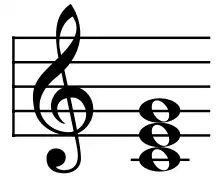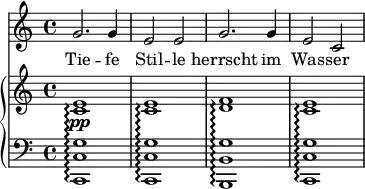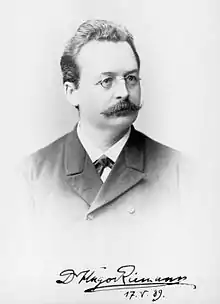

In music, klang (also "clang") is a term sometimes used to translate the German Klang, a highly polysemic word.[3] Technically, the term denotes any periodic sound, especially as opposed to simple periodic sounds (sine tones). In the German lay usage, it may mean "sound" or "tone" (as synonymous to Ton), "musical tone" (as opposed to noise), "note", or "timbre"; a chord of three notes is called a Dreiklang, etc.
Klang has been used among others by Hugo Riemann and by Heinrich Schenker. In translations of their writings, it has erroneously been rendered as "chord" and more specifically as "chord of nature".[4] The idea of the chord of nature connects with earlier ideas that can be found especially in French music theory. Both Hugo Riemann and Heinrich Schenker implicitly or explicitly refer to the theory of the chord of nature (which they recognize as a triad, a Dreiklang), but both reject the theory as a foundation of music because it fails to explain the minor triad. The theory of the chord of nature goes back to the discovery and the description of the harmonic partials (harmonic overtones) in the 17th century.
Klang

The word "klang" (or "clang")[6] has often been used in English as a translation of the German Klang ("sound"), e.g. in the English translation of Riemann's Vereinfachte Harmonielehre.[7] Among the few usages found in scholarly literature to denote the 'chord of nature', one may quote Ruth Solie, who speaks of "the major triad or Naturklang as found in the overtone series",[8] or Benjamin Ayotte, who refers to an article by Oswald Jonas in 1937 which apparently makes use of the term.[9]
The confusion by which the term has been used to denote a chord (instead of a complex sound) probably arises with Rameau's theory of Résonance. Rameau had misunderstood Joseph Sauveur's experiments, intended to demonstrate the existence of overtones, and believed that the harmonic partials arose from a resonance within the fundamental note, to which he gave the name corps sonore,[10] often translated as Klang in German. As Henry Klumpenhouwer writes,
Almost all tonal theorists have proposed that triadic structure arises from a fundamental, conceptually anterior, constituent pitch – such as radix, son fondamental, Grundton, Hauptton – that exerts unity on the collection by means of an array of intervallic relationships sanctioned by Nature.[11]
Klang, he adds,
is technically the German word for 'resonance' or 'sound,' although in this context [of Hauptmann's Harmonik und Metrik] it refers specifically to the ontological entities of major and minor triads, whether generated acoustically or logically.[12]
Klang, therefore, should in most cases better be understood as "the fundamental sound", possibly "the sound of nature".
Riemann defines the Klang as "a compound sound":
The ear comprehends a tone with its direct relatives (third and fifth or their octaves) [...] as forming one compound sound, which we will call a CLANG.
He adds that
a clang may be either principal clang – in which case it is called TONIC – or derived clang [etc.].[13]
And Schenker, although he recognizes that "the Klang as it exists in Nature is a triad",[14] nevertheless stresses that
Nature's help to music consisted of nothing but a hint, a counsel forever mute, whose perception and interpretation were fraught with the gravest difficulties. […] This hint, then, was dropped by Nature in the form of the so-called 'overtone series.' This much-discussed phenomenon, which constitutes Nature's only source for music to draw upon, is much more familiar to the instinct of the artist than to his consciousness. […] I would recommend, however, that we conceive any so called ‘major triad' much more significantly, as a conceptual abbreviation of Nature.[15]
And further:
Any attempt to derive even as much as the first foundation of this [minor] system, i.e., the minor triad itself, from Nature, i.e., from the overtone series, would be more than futile."[16]
Chord of nature
According to Nicholas Cook, the theory of the chord of nature is a striking manifestation of the recurrent strive, "to understand music as an ultimately physical phenomenon".[17]
The theory appears to first have developed in French theory, culminating in Catel's Traité d'harmonie of 1802. Catel writes:
There is in harmony one chord which is the foundation of all others; this chord is formed from the produce of the sonorous body, or primitive divisions of the monochord. Supposing the sound given by the vibration of a whole string when distended, to be G, half of the string when set in vibration will give another sound G, but at the octave of the first. [Etc.: the overtones are described from the 1st to the 23d.] By beginning the progression from the fourth of the string, or from the double octave of the 1st sound, we shall find in progression of thirds the chord G, B, D, F, A. Should the experiment be began at the triple octave, that is the 8th part of the string, and the intermediary sounds be left out, the chord G, B, D, F, A♭, will be produced. […] All the chords used in natural Harmony are contained in this chord and in the foregoing. […] The other Chords introduced in Harmony are formed by the prolongation of one or several notes of a chord into the following; they go by the name of Artificial Harmony.[18]
This became a dogma of the Paris Conservatoire: all chords that can be found in the major or minor dominant 9th are "natural", all others are "artificial".[19] The "chord of nature" is here considered dissonant. Some theorists (including Schenker or Maurice Emmanuel) considered that overtones higher than the fifth (or sixth) could not be heard and that no dissonance could ever be justified by the harmonic series.[20]
Maurice Emmanuel wrote
The musical language, in its foundations, is given by nature: it would seem that it should be universal and spoken in the same way by all people. If this is not so, it is due to the fact that its natural elements are more or less completely understood and used, according to the ages and the countries.[21]
This statement has been one source of Jacques Chailley's evolutionary theory, describing music history as the progressive understanding and usage of higher overtones.[22] The theory of the Chord of Nature was fashionable in the early 20th century. It figures prominently, for instance, in Schönberg's Harmonielehre:
A Klang is composed of a series of tones sounding simultaneously, the overtones; it therefore figures a chord.[23]
Sound of nature
The quotations above have shown the ambiguity of the word "klang", often taken to mean a "chord" but better understood as a complex or compound sound. The theory of the chord of nature does not resist examination because a chord by definition consists of several notes, each with its own overtone series. To view the overtones of a given fundamental note as a natural "model" to be imitated in art, as Schenker does, is not at all the same thing as viewing as model a chord built of several notes above the same root. The Klang, defined by Riemann as a compound sound[13] (i.e. a note with its overtones), and the "chord of nature", defined by Schenker as a model needing "condensation" for the artistic usage[24] are but abstract concepts.
See also
Sources
- ↑ Jonas, Oswald (1982). Introduction to the Theory of Heinrich Schenker (1934: Das Wesen des musikalischen Kunstwerks: Eine Einführung in Die Lehre Heinrich Schenkers), p.16. Trans. John Rothgeb. ISBN 0-582-28227-6. Jonas' example extends to the 16th overtone, but another example gives the first five overtones, shown simultaneously, in quarter notes, unnumbered.
- ↑ Jonas (1982), p.17
- ↑ Alexander J. Ellis devotes a long footnote of his translation of Helmoltz's Sensations of Tone to describe the difficulties in translating Klang and other related German terms meaning tone, musical tone, compound tone, note and simple tone. See Hermann L. F. Helmholtz, On the Sensations of Tone as a Physiological Basis for the Theory of Music, translated, revised and corrected from the fourth German edition of 1877 by Alexander J. Ellis, 2d edition, London, Longman & Co, 1885; reprint New York, Dover, 1954, pp. 24-25, note *.
- ↑ According to Fred Lerdahl (1989). "Atonal Prolongational Structure", p.74, Music and the Cognitive Sciences. McAdams, Stephen and Irene Deliege, eds. ISBN 3718649535, the klang in Riemannian theory is the referential consonant sonority, the tonic triad. But the passage from Riemann's original quoted below does not endorse this, if only because the Klang, for Riemann, is not a chord but a "compound sound", which in addition may or may not represent the tonic. Thomas Pankhurst writes that "Schenker argued that only the first five [overtones] were really audible and that together they made up the basic unit of tonal music – the triad (C, E and G). Schenker attributed almost mystical properties to this chord calling it the 'chord of nature'" (http://www.schenkerguide.com/harmony2.html). As will appear below, Schenker on the contrary clearly implied that the chord of nature, even if it did provide a model of the major triad, could not form "the basic unit of tonal music".
- ↑ Jonas, Oswald (1982). Introduction to the Theory of Heinrich Schenker (1934: Das Wesen des musikalischen Kunstwerks: Eine Einführung in Die Lehre Heinrich Schenkers), p.18. Trans. John Rothgeb. ISBN 0-582-28227-6.
- ↑ Theodore Baker (ed.), Schirmer Pronouncing Pocket Manual of Musical Terms, fourth edition revised by Nicolas Slonimsky, fifth edition revised by Laura Kuhn (New York, London, Paris, Sydney, Copenhagen, Madrid, Tokyo, Berlin: Schirmer Trade Books, 1995): 55. ISBN 9780857122018; Elaine Higgleton, Megan Thomson, Robert Allen, and Catherine Schwarz (eds.), The Chambers Dictionary, new edition (New Delhi: Allied Chambers (India) Limited, 1998): 889. ISBN 978-81-86062-25-8; Benjamin Steege, Helmholtz and the Modern Listener (Cambridge and New York: Cambridge University Press, 2012): 201–202. ISBN 978-1-107-01517-3; John Tyndall, Sound, Eight Lectures, third edition (London: Longmans, Green, and Co., 1875): 114–15; William Dwight Whitney and Benjamin E. Smith (eds.), The Century Dictionary and Cyclopedia, with a New Atlas of the World; a Work of General Reference in Twelve Volumes (New York: The Century Company, 1911): 2:1026.
- ↑ Riemann, Hugo (1893), Vereinfachte Harmonielehre, oder die Lehre von den Tonalen Funktionen der Akkorde. English translation, London, Augener, ca 1895, 2d edition 1903.
- ↑ Solie, Ruth A. (1980). "The Living Work: Organicism and Musical Analysis", 19th-Century Music 4/2, p. 151. The term Naturklang is also attributed to Schenker in Lawrence M. Zbikowski, Conceptualizing Music: Cognitive Structure, Theory, and Analysis, Oxford University Press, 2005, p. 127, etc.
- ↑ Ayotte, Benjamin (2003). Heinrich Schenker: A Research and Information Guide, p. 182. The reference reads as follows: "1937 Jonas, Oswald. 'Mozarts Ewige Melodie.' Der Dreiklang 3 (June): 84–92. Reprinted in Musikerziehung 30/3 and 30/4: 118–21 and 158–60. Discusses the nature of melody as the Auskomponierung of the chord of nature (Klang), i.e., the first five partials of the overtone series; shows the underlying coherence of many Mozart examples, focusing on hidden motivic repetitions." Jonas' German could be more literally translated as follows: "This succession [of notes], however, is nothing else than the Klang, which as given by Nature is indigenous (eingeboren) to the ear; the Klang, as engendered (erzeugt) by the isolated tone (Einzelton) itself, in its intervals". The Klang is here a complex sound, as usual in German, not a chord.
- ↑ André Charrak, Raison et perception. Fonder l'harmonie au XVIIIe siecle, Paris, Vrin, 2002.
- ↑ Klumpenhouwer, Henry (2002). "Dualist Tonal Space and Transformation in Nineteenth-Century Musical Thought", in The Cambridge History of Western Music Theory, edited by Thomas Christensen, Cambridge, p. 458.
- ↑ Klumpenhouwer (2002), p. 460, note 8.
- 1 2 Vereinfachte Harmonielehre, English translation, p. 7.
- ↑ Schenker, Heinrich (1994). "The Art of Improvisation", translated by Richard Kramer, The Masterwork in Music: A Yearbook, Volume 1, 1925, Cambridge Studies in Music Theory and Analysis 4, William Drabkin ed., (Cambridge and New York: Cambridge University Press), p. 3 n2, (translator's note).
- ↑ Schenker, Heinrich (1954). Harmony, O. Jonas ed., E. Mann Borgese transl., Chicago, London, The University of Chicago Press, p. 20-28.
- ↑ Schenker, Heinrich (1954), p. 49.
- ↑ Cook, Nicholas. (2002) "Epistemologies of Music Theory", The Cambridge History of Western Music Theory, p. 86. ISBN 9780521623711.
- ↑ Catel, Simon. (1832) A Treatise on Harmony, translated by Lowell Mason (Boston: James Loring), p. 15-17.
- ↑ Lavignac, Albert. (1896) La musique et les musiciens, 15th edition undated, p. 239: "The chords of dominant 7th, of minor 7th, of diminished 7th, of dominant major 9th and of dominant minor 9th constitute [...] a special group, that of the dissonant natural harmony".
- ↑ Schenker (1954), p. 25: "The human ear can follow Nature as manifested to us in the overtone series only up to the major third as the ultimate limit." Emmanuel, Maurice. (1911) Histoire de la langue musicale, Paris, Laurens, Reprint 1951, vol. I, p. 22-23: "The perception of [overtones] that occur higher [than the fifth] is reserved to ultra sensitive ears. One may say that, in the mean, the phenomenon of resonance is auditively limited to the sounds 1, 2, 3, 4, 5."
- ↑ Emmanuel (1911), vol. I, p. 21.
- ↑ Chailley, Jacques. (1985) Éléments de philologie musicale, Paris, Leduc.
- ↑ Schönberg, Arnold. (1911) Harmonielehre, Vienna: Universal Edition, 1922, p. 19.
- ↑ Schenker, Heinrich (1979), Free Composition, O. Jonas ed., E. Oster transl., § 1



